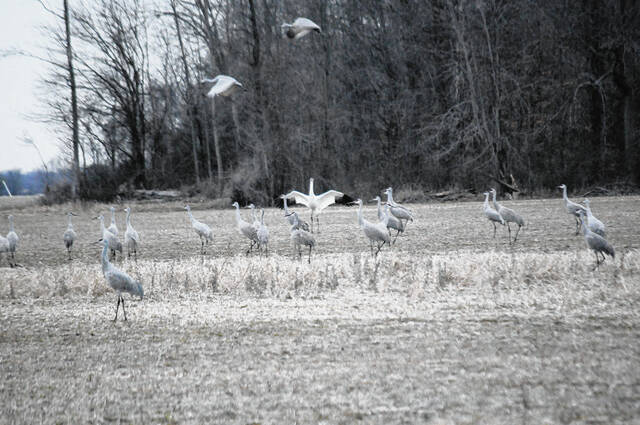While there are thousands of sandhill cranes to be seen in the fields and backwaters of Jackson County this time of year, if you’re lucky, you might be able to spot a tall white bird with black inner wing tips and a red face among them.
The whooping crane is a rare bird, as there are only about 800 of them in existence. Of that number, about 80 of the whooping cranes, which are taller than the sandhill cranes, are located in the eastern part of the United States. About half of that flock visits Indiana annually.
Two whooping cranes have regularly been seen hanging around Jackson County since the early 2000s, said Columbus native and volunteer whooping crane tracker Dan Kaiser. He knows about as much as anyone does about the whooping cranes, which spend some of their time here.
An amateur wildlife photographer, Kaiser has been a volunteer with the International Crane Foundation since 2006 after he spotted a whooping crane while taking pictures of the much more numerous sandhill cranes in Jackson County.
The foundation was short-staffed at the time and thankful for Kaiser’s findings, he said, so that’s when he decided to become a volunteer spotter.
That led to him providing more information to the foundation about when and where he saw the birds and the color bands — used for identification — on their legs.
Kaiser said whooping cranes live in two wild populations, one in the eastern part of the United States and the other in the western part.
The eastern population was introduced in the early 1900s after the western population became nearly extinct. Western whooping cranes mostly spend their winters in Texas, and conservationists were worried that a natural disaster or disease would kill off the breed for good.
Jackson County’s whooping cranes are a part of the eastern population, and those cranes exist thanks to the nonprofit organization Operation Migration.
Back in 2001, Kaiser said Operation Migration started hatching whooping cranes in captivity in an effort to bring the bird back from next extinction.
After the birds have been hatched, Operation Migration raises them in Wisconsin and teaches them to follow an ultralight aircraft. Once strong enough, the whooping cranes will take to the sky and follow the aircraft to learn migration patterns. At times over the years, the aircraft with the young whooping cranes in tow have taken a break at Muscatatuck National Wildlife Refuge just east of Seymour.
An important key to raising these cranes, Kaiser said, was humans dressing in costumes so they wouldn’t relate to humans.
“That’s an important point I want to make,” he said. “We need these birds to stay wild. We don’t need people getting close to them.”
While it’s tempting to approach a whooping crane for a better picture upon a sighting, Kaiser said people should not do that so they can remain wild and survive.
Another important key to the whooping crane’s survival, Kaiser said, is not feeding them to make sure they do not relate to humans.
Of the whooping crane fatalities that happen in the eastern population, Kaiser said 25% of them die from gunshot wounds. In December 2011, a whooping crane was found shot to death in Jackson County. The person who shot it was never found.
The International Crane Foundation emphasizes to not publicize the locations of whooping cranes and to only be specific as to the county where they’re have been spotted.
One whooping crane — No. 14-12 — recently was seen in Jackson County.
The first number identifies what number they hatched from a whooping crane clutch, and the second is the year in which they were born.
Jackson County’s whooping cranes stay here in the winter for the most part, Kaiser said. Weather is a big factor as to when and where they will travel.
If traveling in a pair, the dominant bird of the two will dictate when to leave an area.
Even though whooping cranes have been spotted in Jackson County lately, they will most likely move further south due to cold weather.
Kaiser said he was surprised to hear that they’re still around.
Warmer weather is important to whooping cranes because they roost standing in water at night to know when predators are approaching them. During the day, they fly out to cornfields and join the sandhill cranes to feast on the kernels left from a harvest.


